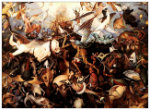Search:: Artists Alphabetically Artists by Country Artists by Century Artists by Movement
Pieter Brueghel the Elder
1525-1569
One of
the Greatest Painters Of All Time
Nickname "Peasant Bruegel"
The Finest Flemish, Painter of the Northern Renaissance
Stylistically influenced by the following painters; Pieter Coecke van Aelst, Hieronymous Bosch and Joachim Patinir
Cause of Death - Typhus
technique - oil or tempera on linen or oak panel
Two of Pieter Brueghl's greatest masterpieces (click to enlarge)
Pieter Brueghel the Elder came from a long line of fine craftsmen and artists. The artist was acclaimed for his genre paintings, peasant scenes and landscapes. He was a very important Flemish Renaissance painter and printmaker that influenced painters for generations to come. He married his teachers beautiful daughter, Mayken van Aelst when he was 21. The combined talent of their genes continued the artistic dynasty for hundreds of years. There is a deliberate serenity to his paintings, by presenting the viewer with cool colors, his work captivates. In composition he is at his best with landscapes. In groups the separate figures are always in harmonious unity. Brueghel was one of most creative individuals to have dominated the world of art. His unrivaled talent and brilliancy, is as fresh today as it was 500 years ago.
Brueghel spent his formative years travelling and later in Antwerp. Author James Edward Parrott descibes the city, "Antwerp, with its deep and convenient river, stretched its arm to the ocean, and caught the golden prize as it fell from its sister cities' grasp. No city except Paris surpassed it in population; none approached it in commercial splendour."
James Edward Parrott further states "The city began to decline during the reign of Philip II., who was King of Spain and master of the Netherlands. In 1576 Spanish soldiers whose pay was in arrears broke into mutiny, and stormed and sacked several of the richest towns of Flanders, including Antwerp. Early in November of that year they entered the city, burnt more than a thousand houses, slew more than eight thousand citizens, plundered right and left, and behaved with the utmost cruelty. Such was the "Spanish Fury," which still forms a landmark in Flemish history. With the help of William of Orange, the Spaniards were driven out of Antwerp."
A List of Pieter Brueghel' s Most
Important Paintings (listed in order of significance and importance)
The Triumph of Death, c. 1562
Landscape with the Fall of Icarus, circa 1555
Hunters in the Snow (1565) Kunsthistorisches Museum, Vienna
The Fall of the Rebel Angels, c. 1562 Oil on oak,
Key Words, People, Phrases, Characteristics related to the Northern Renaissance Art Movement - allegorical painting, rebirth, invention of oil painting, Hieronymus Bosch, Limbourg Brothers, Desiderius Erasmus, Robert Campin, Jan Van Eyck, Jean Fouquet, Albrecht Dürer, Johannes Gutenberg, Johann Reuchlin, Martin Luther, rise of the merchant class, world landscape, Low Countries, Protestant Reformation, Calvinisim, glazing, impasto, scriptorium, illuminator, invention of the printing press, woodcuts, engravings, Antwerp School, Guild of Saint Luke, commerce, Flemish School, Northern Europe, Flanders, Bruges, renewed interest in classical learning, mythological scenes, genre painting, landscapes, portraits, moralizing overtones, human vices, lust, paradise, spirituality, piousness, living a simple life, reform, Human Reasoning, tradesmen at work, idyllic scenes of peasants, playing games, feasting, linear perspective, \Heliocentric Theory, humour, satire, spiritually significant, illuminated manuscript, idealized biblical themes, scriptorium, emotion, illuminator, iconoclast, Age of Discovery, Virgin and Child, axonometric drawing, curiosity about the natural world, realistic use of colours and light, Old Testament stories, Gospel parables, The Blackdeath, Christian symbolism
Important
Northern Renaissance Artists Hieronymus
Bosch (1453
- 1516) Dutch
Dieric
Bouts the Elder (1413-1475) Dutch
Pieter
Brueghel the Elder (1525
- 1569) Flemish
Pieter
Brueghel the Younger (1564
- 1638) Flemish
Lucas
Cranach the Elder (1472
- 1553) German
Albrecht
Dürer (1471
- 1528) German
Matthias
Grünewald (1434-1494) Flemish
Hans
Holbein the Younger (1497-1543) German
Quentin
Massys (1466–1530 Flemish
Rogier
van der Weyden (1399-1464) Dutch
Jan
van Eyck (1385
- 1441) Flemish
Robert
Campin
1375-1444 Dutch
Hans
Melming 1434-1494
German
Petrus
Christus (1420–1476) Netherlandish
Simon
Marmion (1425-1489) French Early
Netherlandish
Jan
Provoost (1465–1529) Flemish
School,
Netherlandish
Hugo
Van Der Goes (1430-1482)
Joos
van Cleve (1485 – 1540) Netherlandish
Joachim
Patinir (1480 –1524) Flemish
School
Hubert van Eyck
Michael
Wolgemut (1434–1519)
Michael Pacher (1435– 1498)
Colijn
de Coter (1445–1532) Netherlandish
Pieter
Pourbus (1523-1584) Flemish
School
Gerard
Horenbout (1465 - 1541) Flemish
School,
Jean
Malouel (1365-1415) French Early Netherlandish
Gerard
David (1469-1519) Early
Netherlandish
If
you feel you have worthwhile information you would like to contribute
we would love to hear from you. We collect essential biographical
information and artist quotes from folks all over the globe and
appreciate your participation. When submitting please, if possible,
site the source and provide English translation. Please
submit your comment to the editor, via e-mail and if possible site the
source. Thank you!
© HistoryofPainters.com
If you like this page and wish to share it, you
are welcome to link to it, with our thanks.
copyright 2017 - historyofpainters.com


